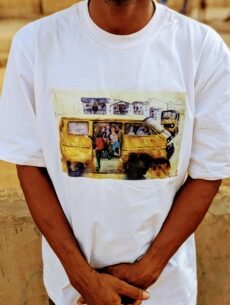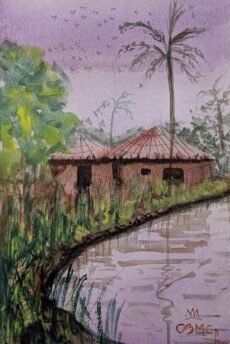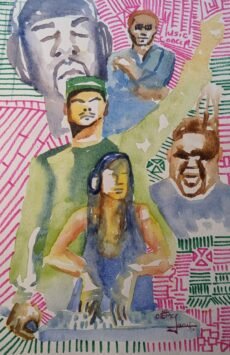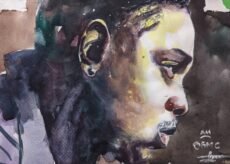Description
“Baba Onilu 2” is a captivating watercolor painting executed on an A3-sized surface, measuring approximately 11.7 x 16.5 inches, a format that strikes a balance between intimate detail and expressive breadth. The title, “Baba Onilu,” translates from Yoruba to “Father of the Drum,” suggesting a celebration of a master drummer, a figure deeply revered in West African culture for their role as a storyteller, spiritual conduit, and keeper of communal rhythm. This artwork, rendered in the fluid and translucent medium of watercolor, captures the vibrancy and soul of this cultural archetype with a dynamic interplay of color, form, and texture.
The composition likely centers on the figure of the drummer, portrayed with a commanding yet graceful presence. The artist employs watercolor’s hallmark qualities—its luminous transparency and unpredictable flow—to evoke the energy of a live performance. The figure’s form is defined by sweeping, confident brushstrokes, with delicate gradients that suggest both physicality and motion. The drummer’s hands, poised over the drum, may be rendered with meticulous detail, capturing the tension and dexterity of a seasoned musician. The drum itself, possibly a traditional djembe or talking drum, serves as a focal point, its curves and taut surface painted with rich earth tones like umber and sienna, accented by subtle highlights that suggest the sheen of stretched hide.
The color palette is a vibrant tapestry, blending warm hues—ochres, burnt oranges, and deep reds—with bursts of cooler tones like turquoise and indigo. These colors do more than depict; they pulsate, mimicking the rhythmic beat of the drum and the emotional intensity of the music. Watercolor’s fluidity allows for soft transitions between shades, creating a sense of movement as if the notes themselves are dancing across the paper. Background elements, perhaps abstract representations of a village setting or a gathered crowd, are suggested through loose, gestural washes, ensuring the focus remains on the drummer while grounding the scene in a cultural context.
Traditional Yoruba motifs may weave through…
Something went wrong, please refresh to reconnect or try again.





Reviews
There are no reviews yet.